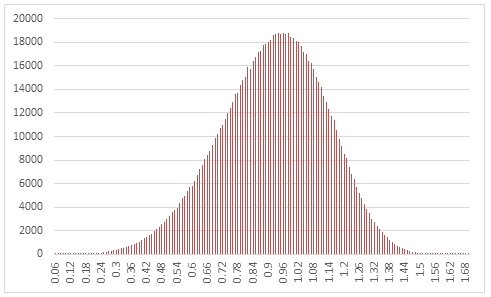SQL Server RANDWEIBULL Function
Updated 2023-10-18 19:39:12.350000
Description
Use the table-valued function RANDWEIBULL to generate a sequence of random numbers from the Weibull distribution with parameters @Shape and @Scale.
Syntax
SELECT * FROM [westclintech].[wct].[RANDWEIBULL](
<@Rows, int,>
,<@Shape, float,>
,<@Scale, float,>)
Arguments
@Rows
the number of rows to generate. @Rows must be of the type int or of a type that implicitly converts to int.
@Shape
the shape parameter. @Shape must be of the type float or of a type that implicitly converts to float.
@Scale
the scale parameter. @Scale must be of the type float or of a type that implicitly converts to float.
Return Type
table
{"columns": [{"field": "colName", "headerName": "Name", "header": "name"}, {"field": "colDatatype", "headerName": "Type", "header": "type"}, {"field": "colDesc", "headerName": "Description", "header": "description", "minWidth": 1000}], "rows": [{"id": "e6d778d7-2643-4dc9-8253-2cd43d4d74a8", "colName": "Seq", "colDatatype": "int", "colDesc": "A monotonically increasing sequence number"}, {"id": "883b810b-b429-49de-8a85-fd97d72d6277", "colName": "X", "colDatatype": "float", "colDesc": "The random variable"}]}
Remarks
@Shape must be greater than zero.
@Scale must be greater than zero.
If @Shape is NULL then @Shape is set to 1.
If @Scale is NULL then @Scale is set to 1.
If @Rows is less than 1 then no rows are returned.
Examples
In this example we create a sequence of 1,000,000 random numbers rounded to two decimal places from a Weibull distribution with @Shape = 5 and @Scale = 1, COUNT the results, paste them into Excel and graph them.
SELECT X,
COUNT(*) as [COUNT]
FROM
(
SELECT ROUND(X, 2) as X
FROM wct.RANDWEIBULL( 1000000, --@Rows
5, --@Shape
1 --@Scale
)
) n
GROUP BY X
ORDER BY X;
This produces the following result.

In this example we generate 1,000,000 random numbers from a Weibull distribution with @shape of 0.5 and @scale of 1. We calculate the mean, standard deviation, skewness, and excess kurtosis from the resultant table and compare those values to the expected values for the distribution.
DECLARE @size as int = 1000000;
DECLARE @shape as float = 0.5;
DECLARE @scale as float = 1;
DECLARE @mean as float = @scale * wct.GAMMA(1e+00 + 1e+00 / @shape);
DECLARE @var as float = POWER(@scale, 2) * ((wct.GAMMA(1 + 2 / @shape) - POWER(
wct.GAMMA(1 + 1 / @shape), 2)));
DECLARE @stdev as float = SQRT(@var);
DECLARE @skew as float
= (POWER(@scale, 3) * wct.GAMMA(1 + 3 / @shape) - 3 * @mean * @var - POWER(
@mean, 3)) / POWER(@stdev, 3);
DECLARE @kurt as float
= (POWER(@scale, 4) * wct.GAMMA(1 + 4 / @shape) - 4 * @skew * POWER(@stdev, 3)
* @mean - 6 * POWER(@mean, 2) * @var
- POWER(@mean, 4)
) / POWER(@stdev, 4) - 3;
SELECT stat,
[RANDWEIBULL],
[EXPECTED]
FROM
(
SELECT x.*
FROM
(
SELECT AVG(x) as mean_WEIBULL,
STDEVP(x) as stdev_WEIBULL,
wct.SKEWNESS_P(x) as skew_WEIBULL,
wct.KURTOSIS_P(x) as kurt_WEIBULL
FROM wct.RANDWEIBULL(@size, @shape, @scale)
) n
CROSS APPLY
(
VALUES
('RANDWEIBULL', 'avg', mean_WEIBULL),
('RANDWEIBULL', 'stdev', stdev_WEIBULL),
('RANDWEIBULL', 'skew', skew_WEIBULL),
('RANDWEIBULL', 'kurt', kurt_WEIBULL),
('EXPECTED', 'avg', @mean),
('EXPECTED', 'stdev', @stdev),
('EXPECTED', 'skew', @skew),
('EXPECTED', 'kurt', @kurt)
) x (fn_name, stat, val_stat)
) d
PIVOT
(
sum(val_stat)
FOR fn_name in ([RANDWEIBULL], [EXPECTED])
) P;
This produces the following result (your result will be different).
{"columns":[{"field":"stat"},{"field":"RANDWEIBULL","headerClass":"ag-right-aligned-header","cellClass":"ag-right-aligned-cell"},{"field":"EXPECTED","headerClass":"ag-right-aligned-header","cellClass":"ag-right-aligned-cell"}],"rows":[{"stat":"avg","RANDWEIBULL":"2.0030448849346","EXPECTED":"2"},{"stat":"kurt","RANDWEIBULL":"86.8376706587384","EXPECTED":"84.72"},{"stat":"skew","RANDWEIBULL":"6.63436577845547","EXPECTED":"6.61876121339938"},{"stat":"stdev","RANDWEIBULL":"4.46758312588545","EXPECTED":"4.47213595499958"}]}
See Also
WEIBULLINV - The inverse Weibull distribution function
RANDBETA - Random numbers from a beta distribution
RANDBINOM - Random numbers from a binomial distribution
RANDCAUCHY - Random numbers from a Cauchy distribution
RANDCHISQ - Random numbers from a chi-squared distribution
RANDEXP - Random numbers from an exponential distribution
RANDFDIST - Random numbers from an F-distribution
RANDGAMMA - Random numbers from a gamma distribution
RANDLAPLACE - Random numbers from a LaPlace distribution
RANDLOGISTIC - Random numbers from a logistic distribution
RANDNORMAL - Random numbers from the normal distribution
RANDPOISSON - Random numbers from a Poisson distribution
RANDSNORMAL - Random numbers from the standard normal distribution